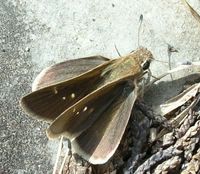
Variegated Meadowhawk, Friedrich Wilderness Park, San Antonio
Sunday there was a chilly wind blowing. We hiked in a park in San Antonio and were high up on a hillside, a long way from water, when we were surprised to see a dragonfly crossing our path. It was that well-known wanderer, the Variegated Meadowhawk (Sympetrum corruptum). My man Stylurus got a decent shot of it perched. A little further up the path a small skipper also let us take its picture. I first identified it here as a female Dun Skipper (Euphyes vestris), but it might be a Clouded Skipper (Lerema accius) -- comments welcome . It warm up after that, but there is just so little natural habitat and public land – all ranches that are heavily grazed – and since it’s still about a week from peak wildflower blooming we were having a hard time finding leps. We stopped at the LBJ National Historic Site and walked the lawns and found many Dainty Sulphurs (Nathalis iole), but not much else. Our last butterfly was a good one, however, a nice California Sister (Adelpha bredowii) cruised by. Odes are still scarce this early in the season. We scanned the creek at the site, but only found a couple of Enallagma and a single dragon flew by, perhaps an Epitheca. That was it for bugs. We did get our target birds, Golden-cheeked Warbler and Black-capped Vireo.
female Dun Skipper, or Clouded Skipper?

